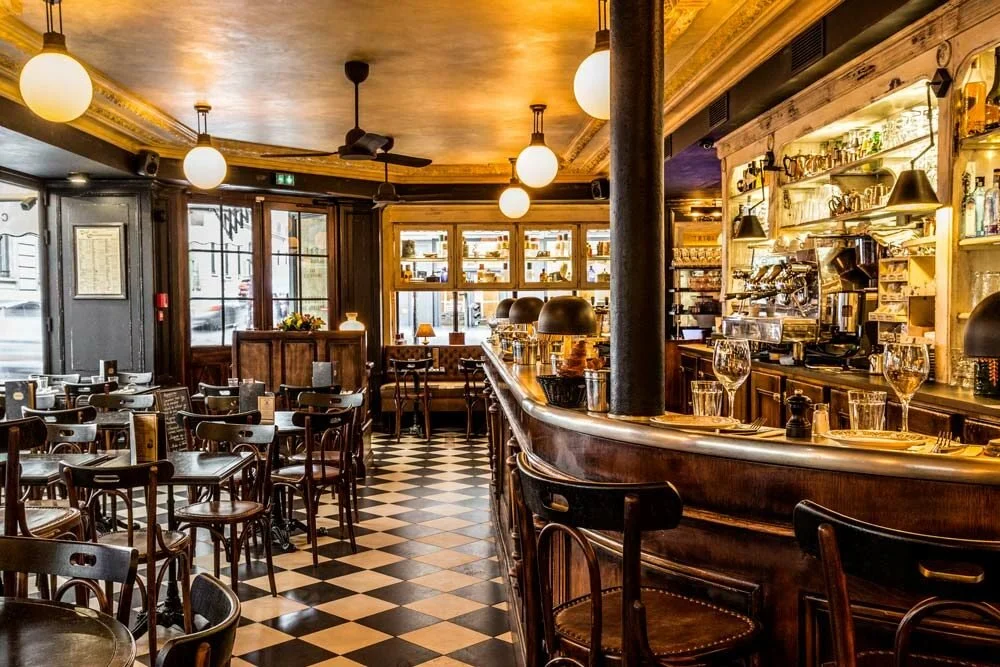
The Parisian bistro is more than just a restaurant—it's a cultural institution, a neighborhood gathering place, and a living testament to French culinary heritage. At Lou Cantou, we honor this rich tradition while adding our own contemporary touch. But to understand where we're going, it's essential to know where we've come from.
Join us on a journey through time as we explore the fascinating evolution of the Parisian bistro, from its humble origins to the beloved establishments that define Parisian dining today.
The Origins: A Russian Beginning
Surprisingly, the word "bistro" has Russian roots. According to popular legend, the term emerged during the Russian occupation of Paris after Napoleon's defeat in 1814. Russian soldiers, impatient for their food, would shout "bystro!"—Russian for "quickly"—prompting Parisian café owners to adopt the term for their establishments serving simple, fast meals.
"The bistro represents the soul of Paris—a place where everyone, from artists to artisans, can find comfort, community, and exceptional food."
The Early Bistros (1820-1860)
Humble Beginnings
The first true bistros emerged in the 1820s, typically operated by working-class Parisians—often former domestic servants or artisans—who converted the front rooms of their apartments into simple eating establishments. These early bistros served as vital community hubs in rapidly growing Paris neighborhoods.
Menu Simplicity
Basic, hearty dishes like pot-au-feu, sausages, and simple stews prepared with affordable ingredients
Social Function
Neighborhood gathering places where locals could eat, drink, and discuss daily affairs
Architecture
Simple storefronts with zinc counters, marble-topped tables, and basic wooden furniture
Clientèle
Working-class Parisians, artisans, and local shopkeepers seeking affordable meals
The Golden Age: Haussmann's Transformation
The mid-19th century marked a turning point for Parisian bistros. Baron Haussmann's massive urban renovation of Paris created wider boulevards and new residential districts, providing perfect locations for bistros to flourish. This period saw the bistro evolve from a simple eating house to a more refined establishment.
The Belle Époque (1870-1914)
Golden Age of Bistros
During the Belle Époque, Parisian bistros reached their zenith. The city's cultural and artistic flowering made bistros the preferred gathering places for writers, artists, and intellectuals. Establishments like Le Procope and La Closerie des Lilas became legendary meeting spots for figures like Hemingway, Picasso, and Sartre.
This era saw significant culinary evolution in bistros:
Expanded Menus
Introduction of classic dishes like steak frites, onion soup, and coq au vin
Wine Culture
Bistros began featuring house wines and developing relationships with specific vineyards
Artistic Haven
Bistros became centers of intellectual and artistic exchange
Architectural Refinement
Mirrored walls, brass fixtures, and comfortable banquettes became standard
The Interwar Years: Challenges and Resilience
The period between World War I and World War II presented significant challenges for Parisian bistros. Economic difficulties and changing social patterns forced many establishments to adapt or close. However, those that survived emerged stronger, having refined their identities and solidified their place in Parisian culture.
It was during this period that many of the classic bistro dishes we know today became standardized. The economic constraints of the era encouraged creativity with humble ingredients, leading to masterpieces like duck confit, ratatouille, and various terrines.
Lou Cantou's Heritage
At Lou Cantou, we draw inspiration from all eras of bistro history. Our zinc counter pays homage to the early bistros, our classic menu items honor the Belle Époque, and our commitment to quality ingredients reflects the best of modern French cuisine. We've preserved the warm, welcoming atmosphere that has always defined the true Parisian bistro experience.
Post-War Evolution and Modern Renaissance
After World War II, Parisian bistros faced new challenges from changing lifestyles and the rise of fast food. However, the 1980s witnessed a bistro renaissance as chefs began rediscovering and reinventing classic bistro cuisine. This "neo-bistro" movement combined traditional techniques with contemporary sensibilities, breathing new life into the format.
The Modern Bistro (1990-Present)
Tradition Meets Innovation
Today's Parisian bistros represent a harmonious blend of tradition and innovation. While honoring classic dishes and maintaining the warm, convivial atmosphere that defines the genre, modern bistros have embraced contemporary culinary techniques, global influences, and a renewed focus on quality sourcing.
Quality Focus
Emphasis on locally sourced, seasonal ingredients and artisanal producers
Creative Freedom
Chefs reinterpret classics while respecting their essential character
Global Influence
Subtle incorporation of international techniques and ingredients
Sustainability
Growing emphasis on ethical sourcing and reduced food waste
The Essential Elements of a True Parisian Bistro
Throughout their evolution, certain elements have remained constant in defining the authentic Parisian bistro experience:
Convivial Atmosphere: The warm, welcoming environment that makes everyone feel at home
Accessible Excellence: High-quality food and drink offered at reasonable prices
Neighborhood Anchor: A place that serves and reflects its local community
Culinary Consistency: Reliable execution of classic dishes that regulars can count on
Personal Connection: The relationship between staff and guests that transforms service into hospitality
A Living Tradition
The story of the Parisian bistro is the story of Paris itself—a narrative of resilience, adaptation, and unwavering commitment to the simple pleasures of good food, good wine, and good company. From the shouted Russian commands that may have given us the name to the sophisticated establishments of today, bistros have continually evolved while preserving their essential character.
At Lou Cantou, we're proud to be part of this ongoing story. We honor the traditions of the past while writing our own chapter in the rich history of Parisian bistros. Every day, we strive to create the warm, welcoming atmosphere and exceptional culinary experiences that have made bistros beloved institutions for nearly two centuries.
The next time you join us for a meal, know that you're participating in a tradition that spans generations—a tradition of community, conversation, and the shared joy of excellent French cuisine.
